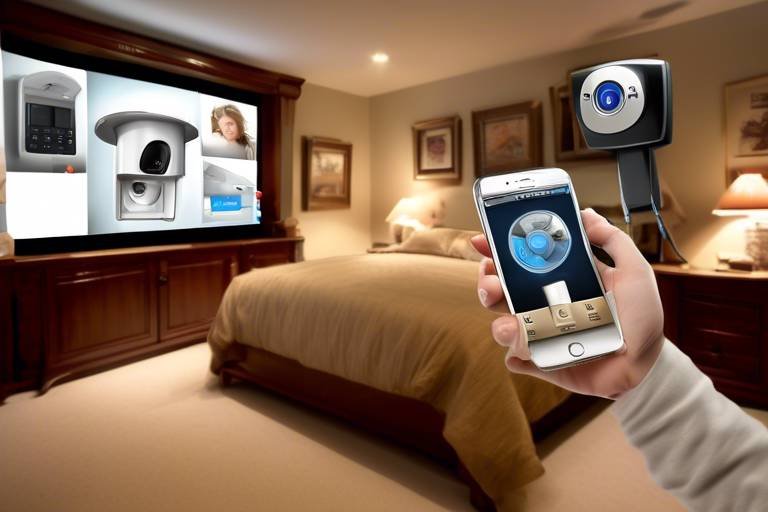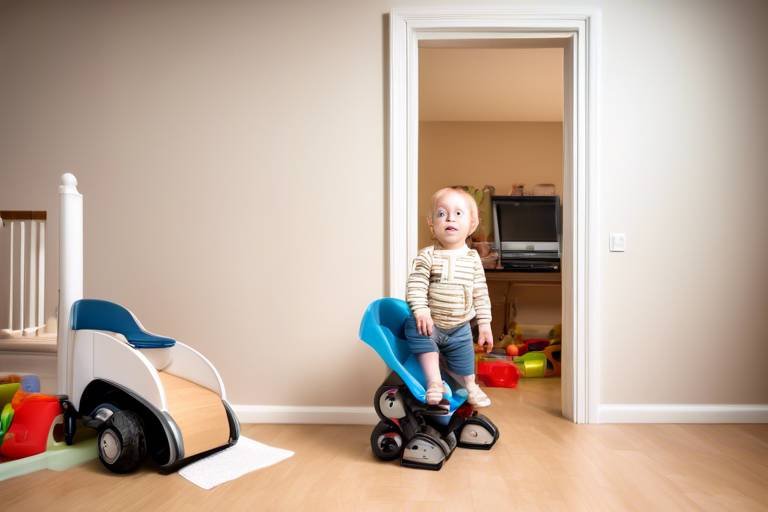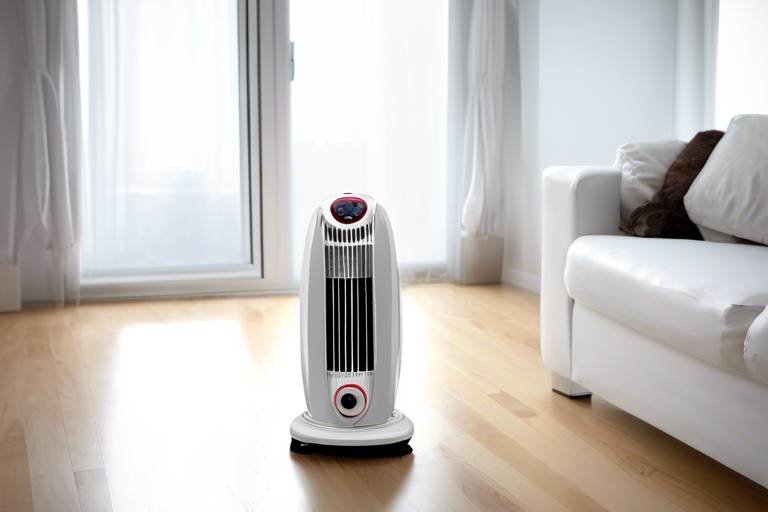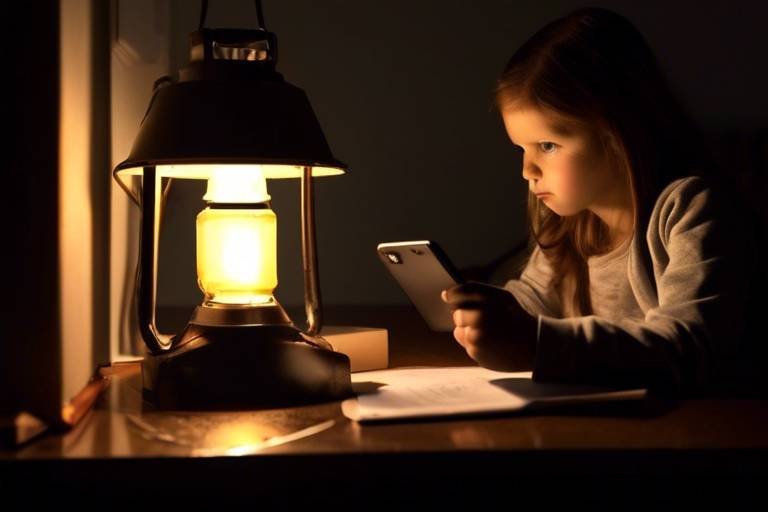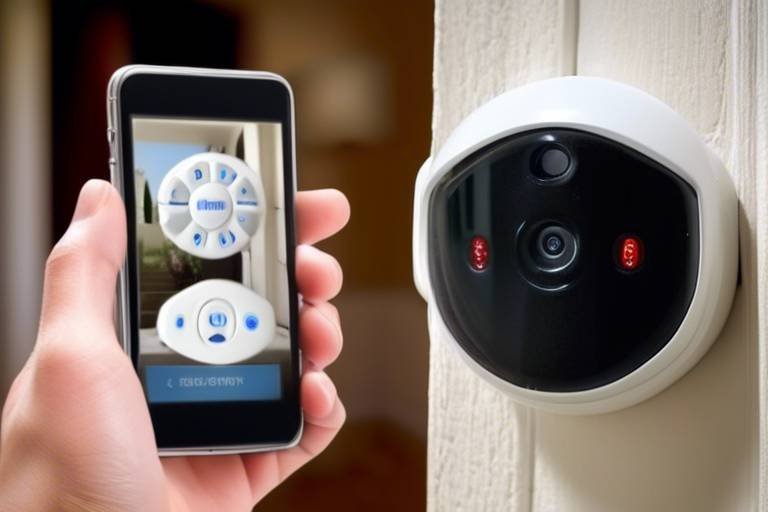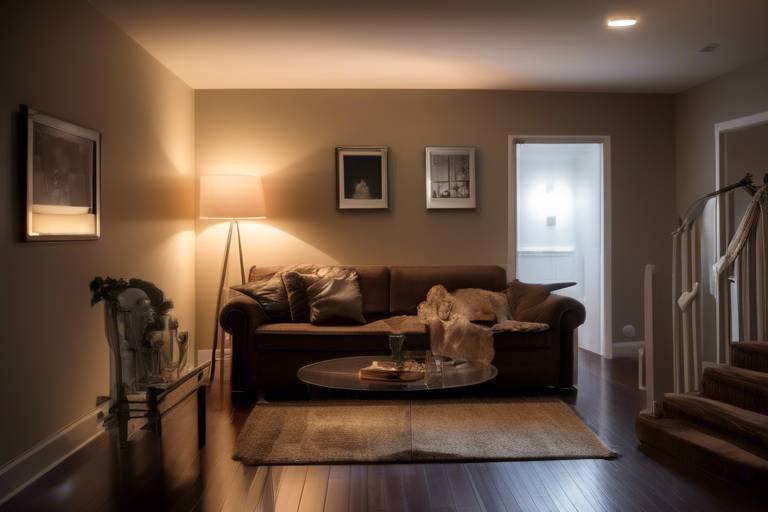The Pros and Cons of DIY Home Security Systems
This article explores the benefits and drawbacks of DIY home security systems, helping homeowners make informed decisions about their security needs and the effectiveness of self-installed solutions.
DIY home security systems empower homeowners to take control of their safety. Unlike traditional security services that often involve lengthy contracts and professional installation, DIY systems allow you to set up your security measures at your own pace and according to your own preferences. Imagine having the freedom to choose exactly what equipment you want, where you want it, and how you want it to function. This flexibility can be a game-changer for many homeowners. DIY systems typically include a range of components such as cameras, motion detectors, and alarms, all of which can be easily integrated into your home environment. The beauty of DIY is that you can adapt your system as your needs change, making it a dynamic solution to home security.
One of the main advantages of DIY systems is their affordability. When you opt for a DIY security solution, you're not just saving on installation fees; you're also avoiding the ongoing costs associated with professional monitoring services. Think about it: traditional security systems can set you back hundreds of dollars upfront, plus monthly fees that can add up over time. In contrast, many DIY systems offer a one-time purchase price with optional monitoring features that are often much cheaper. For instance, you might find a system that costs around $200, while traditional services could charge you $30 or more each month. Over the course of a year, that's a significant saving!
The installation process for DIY home security systems can be straightforward, making it accessible even for those who aren’t particularly tech-savvy. Most kits come with detailed instructions and user-friendly interfaces that guide you through the setup. Typically, you’ll need to follow these steps:
- Unbox your equipment and check all components.
- Choose strategic locations for cameras and sensors.
- Mount the devices and connect them to your home Wi-Fi.
- Download the corresponding app and sync your devices.
Another standout feature of DIY systems is the high degree of customization they offer. Homeowners can tailor their security solutions to fit their unique needs. You can choose from a variety of components, such as indoor and outdoor cameras, smart locks, and environmental sensors. This means if you live in a high-risk area, you might opt for additional cameras or motion sensors. Alternatively, if you have pets, you can select motion detectors that won’t be triggered by their movements. The ability to personalize your security setup not only enhances effectiveness but can also provide peace of mind.
Monitoring capabilities are crucial in any security system. With DIY systems, you often have the option to monitor your home through smartphone apps and cloud services. This means you can receive real-time alerts about any unusual activity, whether it’s an open door or motion detected outside. Many systems also allow you to view live feeds from your cameras, giving you a sense of control even when you're away from home. The convenience of managing your security from your phone is akin to having a personal security guard in your pocket!
The reliability of DIY home security systems can vary. While many users report satisfaction with their systems, others have experienced issues related to connectivity or false alarms. It’s essential to research and select a reputable brand known for its performance. User experiences can provide valuable insights into how effective these systems are in real-world scenarios. For example, a system that works flawlessly in one neighborhood might struggle in another due to varying internet speeds or environmental factors. Understanding these nuances can help you make a more informed decision.
Technical support is essential for any DIY project. Fortunately, many DIY home security brands offer comprehensive resources and customer support options. From online tutorials to live chat support, you can find assistance when you need it most. However, keep in mind that the level of support can vary by brand. Some companies provide excellent customer service, while others may leave you feeling stranded. Before purchasing a system, it’s wise to check reviews and see how other users have fared with technical support.
Despite their benefits, DIY systems may pose security risks. For instance, if not properly secured, your system could be vulnerable to hacking. It’s crucial to change default passwords and regularly update your system’s software to mitigate these risks. Additionally, some users might overlook critical components, such as window sensors or outdoor cameras, leaving gaps in their security. Awareness of these vulnerabilities can help homeowners make informed choices and avoid common pitfalls when opting for DIY solutions.
In conclusion, we’ve explored the pros and cons of DIY home security systems. While they offer cost-effectiveness, customization, and control, potential risks and reliability concerns should not be ignored. Assessing your security needs and lifestyle preferences is vital in determining whether a DIY approach aligns with your goals. If you value flexibility and are comfortable with technology, a DIY system might be the perfect fit for you. On the other hand, if you prefer a hands-off approach, a professionally monitored system may be more suitable.
1. Are DIY home security systems easy to install?
Most DIY systems are designed for easy installation, often requiring no special tools or expertise.
2. Can I monitor my DIY system from my smartphone?
Yes! Most DIY systems come with smartphone apps that allow you to monitor your home remotely.
3. What happens if my Wi-Fi goes down?
Some systems have backup options, such as cellular connectivity, but it's important to check the specifications of your chosen system.
4. How can I ensure my DIY system is secure?
Change default passwords, enable two-factor authentication, and keep your system updated to enhance security.

Understanding DIY Home Security
When it comes to keeping your home safe, the term DIY home security systems has become a buzzword in recent years. But what exactly does it mean? Unlike traditional security services that often require professional installation and monitoring, DIY systems empower homeowners to take matters into their own hands. Imagine having the ability to set up your own security measures without waiting for a technician to arrive. Sounds liberating, right?
DIY home security systems typically consist of various components such as cameras, sensors, alarms, and smart devices that can be installed and managed by the homeowner. The beauty of these systems lies in their flexibility and customization. You’re not locked into a one-size-fits-all solution. Instead, you can choose the devices and features that best suit your specific needs. This could mean anything from motion detectors in the backyard to smart locks on your doors. The options are as diverse as the homeowners themselves!
One of the key differences between DIY and traditional security systems is the level of control you have. With DIY systems, you are the master of your own domain. You can monitor your home through mobile apps, receive notifications directly to your smartphone, and even control your security settings remotely. This kind of accessibility is a game-changer for many people. Imagine being on vacation and still having the peace of mind that comes from knowing you can check your home security with just a few taps on your phone.
However, it’s important to note that with great power comes great responsibility. While DIY systems offer a level of autonomy that many homeowners crave, they also require a certain degree of technical know-how. You’re not just plugging in a device and calling it a day; you’ll need to understand how to set up and configure your system properly. For some, this challenge is exciting and empowering, while others may find it overwhelming. It’s a bit like assembling IKEA furniture—some people love the process, while others would rather have it done for them!
In summary, understanding DIY home security means recognizing the balance between empowerment and responsibility. If you’re tech-savvy and enjoy hands-on projects, a DIY system could be a perfect fit. But if you prefer a more hands-off approach, it might be worth considering a traditional security service. The choice ultimately comes down to your personal preferences and comfort level with technology.

Cost-Effectiveness
When it comes to securing your home, the of DIY home security systems often stands out as a major selling point. Unlike traditional security services, which can come with hefty installation and monthly monitoring fees, DIY systems allow homeowners to take control of their security without breaking the bank. Imagine being able to set up a robust security solution for a fraction of the price! This financial freedom can be particularly appealing for those on a budget or for families looking to allocate their resources elsewhere.
Let’s break it down a bit. With DIY systems, you typically pay a one-time fee for the equipment, which can include cameras, sensors, and alarms. On average, these systems can range from $200 to $600 for an entire setup, depending on the features and quality you choose. In contrast, a professionally monitored system can cost anywhere from $30 to $60 per month in monitoring fees alone, plus installation costs that can skyrocket to over $1,000! The savings can be quite significant, especially over time.
Here’s a simple table comparing the costs:
| Type of System | Initial Cost | Monthly Fees |
|---|---|---|
| DIY Home Security | $200 - $600 | $0 - Optional |
| Professionally Monitored System | $1,000+ | $30 - $60 |
Not only do DIY systems save you money upfront, but they also eliminate ongoing monthly fees. Instead of paying for a service you might not need, you can invest in quality equipment that you own outright. This means that, in the long run, your DIY system can pay for itself, allowing you to redirect those funds into other important areas of your life, whether that’s home improvements or family activities.
Of course, it’s essential to consider the trade-offs. While the savings are appealing, some homeowners may feel uncomfortable with the idea of managing their own security. After all, a DIY system requires a bit of tech-savviness and a willingness to troubleshoot issues that may arise. However, many manufacturers offer extensive online resources and customer support, making it easier than ever to navigate any hiccups.
In summary, the cost-effectiveness of DIY home security systems is a compelling reason to consider this option. With lower initial costs, no monthly fees, and the ability to customize your setup, it’s a practical choice for many homeowners. But as with any investment, it’s crucial to weigh the benefits against your personal comfort level with technology and self-management.

Installation Process
When it comes to DIY home security systems, the is one of the most appealing aspects for many homeowners. Imagine being able to set up your own security system without waiting for a technician to arrive. Sounds liberating, right? The good news is that most DIY systems are designed with user-friendliness in mind, allowing even the least tech-savvy individuals to get their systems up and running in no time.
Typically, the installation process involves a few straightforward steps. First, you’ll need to unbox your equipment and familiarize yourself with the components. Most DIY systems come with a variety of devices, including cameras, motion sensors, and control panels. Each component usually has a user manual that provides detailed instructions. So, take a moment to read through it before diving into the installation.
Next, you’ll want to choose strategic locations for your devices. Think of your home as a fortress; you need to identify the vulnerable points. Common areas include entryways, windows, and even garages. This is where the magic happens—deciding where to place your cameras and sensors can significantly enhance your security coverage. Make sure to consider factors like visibility and accessibility.
After you’ve mapped out your plan, it’s time to mount the devices. Most systems come with adhesive strips, screws, or brackets for mounting. If you’re using cameras, ensure they are positioned at angles that cover as much ground as possible. For motion sensors, placing them in corners can help maximize their detection range. If you run into any hiccups, many manufacturers offer online tutorials or customer support to guide you through the process.
Once everything is installed, you’ll need to connect your system to your home Wi-Fi. This step is crucial for remote monitoring and alerts. The control panel or smartphone app will guide you through this process, often requiring you to input your Wi-Fi credentials. This is where the magic of modern technology comes into play, allowing you to monitor your home from anywhere in the world. Imagine being on vacation and checking in on your home with just a few taps on your smartphone!
However, while the installation process is generally straightforward, some homeowners may face challenges. For instance, if you live in a larger home, you might need to consider the range of your Wi-Fi signal or invest in a range extender. Additionally, integrating various components can sometimes lead to compatibility issues. Therefore, it’s essential to do a bit of research before purchasing your system to ensure all parts will work seamlessly together.
In summary, the installation process of DIY home security systems can be a rewarding experience. With a little planning and patience, you can create a customized security setup that meets your specific needs. Just remember, the key is to take your time, follow the instructions, and don’t hesitate to reach out for help if you need it. After all, the goal is to secure your home effectively, and a well-installed system is the first step toward achieving that.
- How long does the installation process take? The installation can typically be completed in under two hours, depending on the complexity of your system and your familiarity with the devices.
- Do I need any special tools for installation? Most DIY systems come with everything you need, but having a screwdriver and a level on hand can make the process easier.
- Can I install the system myself if I’m not tech-savvy? Absolutely! Most DIY systems are designed for ease of use, and there are plenty of resources available to help you.
- What if I encounter problems during installation? Don’t worry! Most manufacturers offer customer support, online tutorials, and community forums to assist you.

Customization Options
When it comes to DIY home security systems, one of the standout features is the level of customization they offer. Unlike traditional security services that often come with a one-size-fits-all approach, DIY systems allow homeowners to tailor their security solutions to fit their specific needs and preferences. Imagine being able to design a security setup that aligns perfectly with your lifestyle and the layout of your home. That’s the beauty of going DIY!
Customization starts with the choice of components. Most DIY systems include a variety of devices such as cameras, motion detectors, door/window sensors, and even smart locks. Homeowners can mix and match these devices based on the areas they want to monitor. For instance, if you live in a neighborhood with a high foot traffic, you might opt for additional outdoor cameras to keep an eye on your property. On the other hand, if you have a large backyard, adding motion sensors in those areas can enhance your security.
Moreover, many DIY systems come with smart home integrations. This means you can connect your security system to other smart devices in your home, such as lights, thermostats, and voice assistants. Picture this: you arrive home late at night, and as you approach your front door, your outdoor lights automatically turn on, and your smart lock unlocks as you reach for it. This level of integration not only adds convenience but also enhances your home’s security.
Another exciting aspect of customization is the ability to choose your monitoring options. Some DIY systems allow you to opt for self-monitoring, where you receive alerts directly on your smartphone through an app. This gives you immediate control and oversight of your home security. Alternatively, you can choose to subscribe to a professional monitoring service, which can provide an added layer of security. The choice is entirely yours!
To help you visualize the different components available for customization, here’s a simple table:
| Component | Description | Customization Options |
|---|---|---|
| Cameras | Indoor and outdoor surveillance cameras | Resolution, field of view, night vision |
| Motion Detectors | Devices that detect movement | Sensitivity settings, zones of detection |
| Door/Window Sensors | Magnetic sensors for entry points | Placement options, alarm settings |
| Smart Locks | Keyless entry systems | Access codes, remote locking/unlocking |
In addition to hardware, software customization plays a crucial role as well. Many DIY systems provide user-friendly apps that allow you to set preferences, schedule alerts, and even create automation rules. For example, you can program your system to send you a notification if a door is opened after a certain hour, or to trigger a camera when motion is detected in a specific area. This level of control is what makes DIY systems so appealing to many homeowners.
Ultimately, the customization options available with DIY home security systems empower homeowners to create a security environment that is not only effective but also perfectly suited to their lifestyles. It’s like crafting a tailored suit; everything fits just right, giving you peace of mind and confidence in your home’s safety.
- Can I add more devices to my DIY security system later?
Yes, most DIY systems are designed to be expandable, allowing you to add additional devices as needed. - Are DIY security systems easy to install?
Generally, yes! Many systems come with straightforward instructions, making installation accessible even for those who aren’t tech-savvy. - What happens if my internet goes down?
Some systems offer local storage options, but many rely on internet connectivity for monitoring and alerts. Check your system’s specifications for details.

Monitoring and Alerts
When it comes to home security, are the backbone of any effective system. For DIY home security systems, this aspect is not just an added bonus; it’s a crucial component that can make or break your peace of mind. Imagine being able to receive real-time notifications while you're at work, on vacation, or even just out for a jog. This capability is what transforms a simple alarm system into a comprehensive security solution.
Most DIY systems come equipped with smartphone apps that allow homeowners to monitor their property from anywhere. These apps can send alerts for various activities, such as motion detection, door/window openings, or even environmental changes like smoke or water leaks. The convenience of having this information at your fingertips is akin to having a personal security guard available 24/7. But how does this actually work?
Typically, DIY security systems utilize a combination of sensors and cameras connected to a central hub. When a sensor is triggered, it sends a signal to the hub, which then alerts your smartphone via the app. This process can happen in mere seconds, giving you the ability to respond quickly. For instance, if your motion detector picks up movement in your backyard, you can check the live feed from your security camera right from your phone. It's like having a virtual eye on your home at all times!
However, it’s important to consider the reliability of these alerts. While many systems boast impressive features, not all are created equal. Some may experience delays or false alarms, which can lead to unnecessary panic or, worse, complacency. To give you a clearer picture, here’s a quick comparison of various DIY monitoring options:
| System Type | Alert Speed | False Alarm Rate | App Features |
|---|---|---|---|
| Basic Alarm System | Moderate | High | Basic Notifications |
| Smart Camera System | Fast | Low | Live Streaming, Two-Way Audio |
| Comprehensive Security Suite | Very Fast | Very Low | Smart Notifications, Cloud Storage |
As you can see from the table, not all systems are equal when it comes to monitoring and alerts. The more advanced systems tend to offer quicker alerts and lower false alarm rates, which can significantly enhance your overall security experience. Additionally, many of these systems integrate with other smart home devices, allowing for a more cohesive security strategy.
In conclusion, while DIY home security systems offer the allure of autonomy and cost savings, the effectiveness of their monitoring and alert features can vary widely. Homeowners should carefully evaluate their options, considering factors like alert speed, false alarm rates, and app functionalities. After all, the ultimate goal is to feel safe and secure in your own home, and having a reliable monitoring system is a key step in achieving that peace of mind.

Reliability and Performance
When it comes to home security, the reliability and performance of your system are paramount. After all, what's the point of having a security system if it fails to protect your home when you need it the most? DIY home security systems can vary significantly in terms of their reliability, and understanding these differences can help you make an informed choice. Many homeowners are drawn to DIY solutions because they offer the promise of control and flexibility, but this can sometimes come at the cost of performance.
One of the key factors affecting the reliability of DIY systems is the quality of the components used. Unlike professionally installed systems, which often come with high-end equipment, DIY systems may rely on more affordable options that can impact their effectiveness. For example, a budget-friendly camera might not perform well in low-light conditions, leaving your home vulnerable during the night. It's crucial to research and choose products from reputable brands that have been tested for reliability.
Moreover, the performance of these systems is also influenced by the homeowner's technical skills. While many systems are designed for easy installation, not everyone is a DIY expert. A poorly installed device can lead to false alarms or, worse, a failure to alert you during a real emergency. Therefore, it's essential to follow installation instructions meticulously and consider watching tutorial videos if you're unsure about any steps. If you find yourself struggling, don't hesitate to reach out for help, either from friends or professionals.
Another critical aspect of reliability is the system's ability to communicate effectively. Many DIY systems rely on Wi-Fi for connectivity, which can be a double-edged sword. On one hand, it allows for easy remote monitoring via smartphone apps. On the other hand, if your internet goes down, so does your security. To mitigate this risk, consider systems that offer battery backups or cellular options to ensure continuous operation even during outages.
To provide a clearer picture of how DIY systems stack up in terms of reliability and performance, here’s a comparison of some common features:
| Feature | DIY Systems | Professional Systems |
|---|---|---|
| Installation | Self-installed, variable quality | Professionally installed, consistent quality |
| Monitoring | Smartphone app-based, may rely on Wi-Fi | 24/7 monitoring service, more reliable |
| Cost | Lower upfront costs | Higher upfront and monthly fees |
| Customization | Highly customizable | Limited customization options |
Ultimately, the effectiveness of a DIY home security system boils down to a combination of the equipment you choose, your installation method, and how well the system integrates with your lifestyle. If you are tech-savvy and willing to invest time in setting up and maintaining your system, you might find that a DIY solution meets your needs perfectly. However, if you prefer peace of mind and a system that works seamlessly without much intervention, opting for a professional installation might be the better route.
- Are DIY home security systems effective? Yes, they can be effective if properly installed and maintained, but their reliability can vary based on equipment quality and user skill.
- What are the common issues with DIY systems? Common issues include connectivity problems, false alarms due to poor installation, and reliance on Wi-Fi.
- Can I upgrade my DIY system later? Yes, many DIY systems allow for easy upgrades and additions as your security needs evolve.

Technical Support and Resources
When you choose a DIY home security system, one of the most critical aspects to consider is the technical support and resources available to you. Unlike traditional security systems where professional technicians are just a call away, DIY systems often require you to be more self-reliant. However, this doesn't mean you’re left in the dark; many manufacturers offer a wealth of resources to help you navigate any challenges you might face.
Most DIY security systems come with comprehensive installation manuals and online tutorials that can simplify the setup process. These resources often include video guides, FAQs, and troubleshooting tips that can help you resolve common issues without needing to contact customer support. For instance, if you encounter connectivity issues with your security cameras, a quick search through the manufacturer’s website might reveal a solution that other users have found effective.
In addition to documentation, many companies provide customer support channels, which can include:
- Live Chat: Instant messaging support where you can get real-time assistance.
- Email Support: A way to submit your questions and receive detailed responses.
- Phone Support: Direct access to customer service representatives for more complex issues.
It's essential to check the availability and responsiveness of these support options before committing to a particular system. Some brands are known for their exceptional customer service, while others might leave you hanging during critical times. One way to gauge this is by reading customer reviews and testimonials, which can provide insights into the experiences of other users regarding support.
Moreover, many DIY security systems are integrated with smartphone applications that not only allow you to monitor your home but also provide access to customer support. These apps often feature forums or community sections where users share their experiences and solutions, creating a virtual support network that can be incredibly valuable.
In summary, while DIY home security systems place a greater emphasis on self-sufficiency, the availability of technical support and resources can significantly ease the process. By leveraging the right tools and support channels, you can confidently manage your home security without feeling overwhelmed. Always remember to evaluate the support options available before making your final decision, as this can greatly influence your overall experience with your DIY system.
As you consider a DIY home security system, you may have some questions. Here are a few frequently asked questions that can help clarify your concerns:
- What should I look for in a DIY security system? - Look for ease of installation, good customer support, and a range of customizable options.
- Can I expand my system later? - Most DIY systems allow for expansion, so you can add more cameras or sensors as needed.
- How secure are DIY systems? - While many are quite secure, it's essential to stay updated with software and firmware to protect against vulnerabilities.

Potential Security Risks
While DIY home security systems offer numerous benefits, it's crucial to recognize that they also come with their own set of . Understanding these vulnerabilities can help homeowners make more informed decisions about whether to go the DIY route or opt for professional services. One significant concern is the lack of professional monitoring. Unlike traditional systems that are monitored 24/7 by security professionals, many DIY systems rely on the homeowner to respond to alerts. This can lead to delayed reactions in emergency situations, which can be detrimental.
Another risk involves the security of the devices themselves. Many DIY systems operate over Wi-Fi, making them susceptible to hacking if not properly secured. Homeowners must ensure their network is fortified with strong passwords and updated firmware. If a hacker gains access, they can disable the system or even spy on the homeowner. Additionally, some DIY systems may not encrypt data effectively, leaving personal information vulnerable.
It's also worth noting that not all DIY systems are created equal. Some systems may have poor build quality or unreliable components, which can lead to false alarms or failures to detect real threats. For instance, if the motion sensors are overly sensitive, they may trigger false alarms from pets or passing cars, leading to alarm fatigue. This can cause homeowners to ignore genuine alerts, undermining the system's effectiveness.
Moreover, the installation process can pose risks if not done correctly. Homeowners who are not tech-savvy might misconfigure their systems, leaving gaps in their security. For example, if cameras are not positioned correctly, they may not capture critical areas, such as entry points. It's essential for users to follow installation guidelines meticulously to avoid creating vulnerabilities.
In addition to these risks, homeowners should also consider the lack of comprehensive support. While many DIY systems come with customer service options, they may not provide the same level of assistance as a professional service. If a homeowner encounters a technical issue, they may find themselves troubleshooting without adequate guidance, which could lead to further security lapses.
In summary, while DIY home security systems can be a cost-effective and customizable option, they are not without risks. Homeowners should weigh these potential vulnerabilities against the benefits and consider whether they have the technical know-how to manage their own security effectively. It's essential to stay informed and proactive to ensure that your DIY system is as secure as possible.
- What are the most common security risks associated with DIY systems?
Common risks include hacking vulnerabilities, poor build quality, and improper installation.
- How can I secure my DIY home security system?
Use strong, unique passwords, enable two-factor authentication, and regularly update your devices.
- Is professional monitoring worth the cost?
Professional monitoring can provide peace of mind and faster response times in emergencies, which may be worth the investment for some homeowners.

Conclusion: Is DIY Right for You?
In wrapping up our exploration of DIY home security systems, it's essential to weigh the pros and cons carefully. Are you the type of person who enjoys hands-on projects, or do you prefer the peace of mind that comes with professional installation? Choosing the right security system often boils down to your personal preferences, budget, and how much time you're willing to invest in setting it up.
One of the most appealing aspects of DIY systems is their affordability. With no monthly monitoring fees, you can save a significant amount of money over time. However, it’s crucial to consider whether these savings are worth the potential downsides, such as the lack of professional support. If you're tech-savvy and enjoy customizing your solutions, a DIY system may be a perfect fit. On the other hand, if you find yourself overwhelmed by technology or prefer a hands-off approach, a professionally monitored system might be the better choice.
Moreover, think about the level of security you need. DIY systems can be tailored to meet your specific needs, offering flexibility that traditional systems might lack. But, they also come with potential vulnerabilities that could leave your home at risk if not properly managed. Understanding these nuances is key to making an informed decision.
Ultimately, the choice between DIY and professional security comes down to what makes you feel safe and secure in your own home. Whether you opt for a DIY solution or a more traditional approach, the most important thing is that you take action to protect your living space. So, are you ready to take the plunge into the world of DIY home security, or do you feel more comfortable with the reassurance of a professional service? The answer lies in your individual needs and preferences.
- What are the key benefits of DIY home security systems? DIY systems are typically more affordable, customizable, and allow homeowners to have full control over their security setup.
- Are DIY security systems reliable? While many DIY systems are reliable, their effectiveness can vary based on the installation quality and the technology used.
- Can I monitor my DIY system remotely? Yes, most DIY systems come with smartphone apps that allow you to monitor your home security from anywhere.
- What should I consider before choosing a DIY system? Consider your technical skills, budget, and the level of customization you desire, as well as the potential security risks involved.
Frequently Asked Questions
- What are DIY home security systems?
DIY home security systems are self-installed security solutions that allow homeowners to manage their own safety without relying on professional services. These systems typically include components like cameras, alarms, and sensors that you can set up on your own, giving you full control over your home security.
- How much can I save by choosing a DIY home security system?
One of the biggest advantages of DIY systems is their cost-effectiveness. You can save on installation fees, monthly monitoring costs, and equipment prices compared to traditional security services. Many DIY systems offer a one-time purchase option, so you won't have to worry about ongoing expenses.
- Is the installation process difficult?
Not at all! Most DIY home security systems are designed for easy installation. You typically just need to follow the manufacturer’s instructions, which often include user-friendly guides and videos. However, some users may face challenges with technical setup, especially if they're not tech-savvy.
- Can I customize my DIY security system?
Absolutely! One of the best features of DIY systems is their high degree of customization. You can choose from various components—like cameras, door sensors, and smart locks—to create a security solution that fits your specific needs and lifestyle.
- How do DIY systems handle monitoring and alerts?
Most DIY home security systems come with smartphone apps that allow you to monitor your home in real-time. You’ll receive alerts and notifications directly to your phone, ensuring you’re always in the loop about your home’s security status.
- Are DIY home security systems reliable?
Reliability can vary between different DIY systems. While many users report positive experiences, it’s important to research and read reviews about specific products. Factors like internet connectivity and system updates can also impact performance.
- What kind of technical support is available for DIY systems?
Many DIY home security brands offer extensive customer support, including online resources, FAQs, and customer service hotlines. Some even provide community forums where users can share tips and troubleshoot issues together.
- Are there any security risks with DIY systems?
Yes, while DIY systems have many benefits, they can also come with vulnerabilities. Common risks include weak passwords, outdated software, and lack of professional monitoring. It's essential to stay informed and take necessary precautions to secure your system.
- How do I decide if a DIY system is right for me?
Consider your budget, technical skills, and personal preferences. If you want control over your security setup and are comfortable with technology, a DIY system might be a great fit. However, if you prefer professional assistance, a traditional system could be a better choice.







